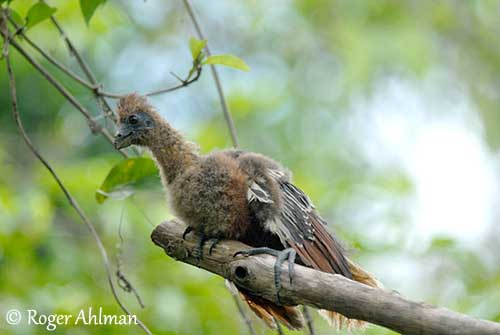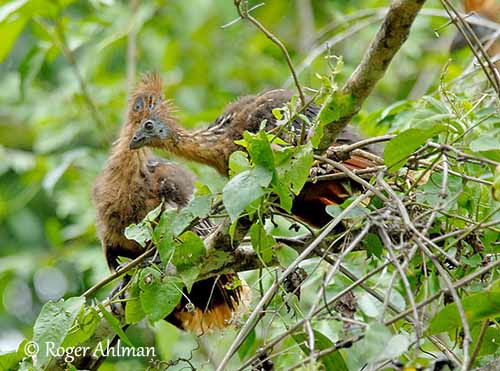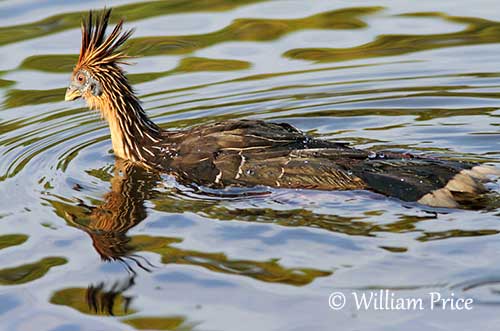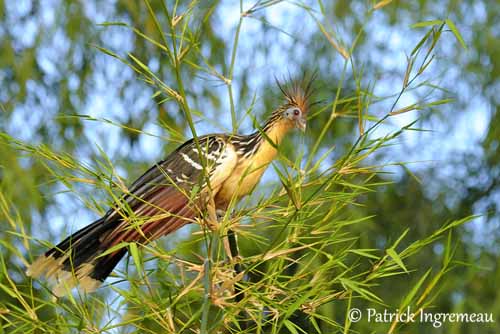
Hoatzin
Opisthomocus hoazin
Opisthocomiforme Order - Opisthocomidae Family
BIOMETRICS:
Length: 61 - 66 cm; Weight : 700 - 900 gr.
LONGEVITY: 8 years (probably more)
DESCRIPTION:
Hoatzin is a colourful bird, with frizzy crest and long tail. We can say it has a “Prehistoric” appearance with particular “wing claws” similar to those present on the wings of the first known lizard-bird, the Archaeopteryx.
Small head is almost bare. Neck is long. Hoatzin has frizzy red-orange crest of about 4 to 8 cm long, starting on forehead. We can see a large bright blue area of bare skin around the eye. Eyes are red. Pale brown bill is short and relatively bulky. Legs and feet are blackish.
Both sexes are similar, with female slightly smaller than male, and with lower crest.
Nestlings have very thick dark brown down and two small claws on each wing which enables them to climb up branches a few times after hatching. These claws are situated on first and second phalanxes of wing articulation.
Young reach their sexual maturity at one year.
BEHAVIOUR:
Hoatzin adults gather in flocks of up to 10 to 50 birds, moving in trees, feeding on arum leaves and other marsh vegetation. They forage in the early morning and early evening. They spend much of their time roosting quietly and digesting their meal.
They live in family groups and small flocks, and they are gregarious all year round.
During breeding season, Hoatzin nests in colonies up to 28 birds, and some of them are helpers. They are subadults and adults, often young of previous clutches. Helpers are particularly active in territorial defence, and they assist in nest building, incubation, brooding, and feeding young. But only about 50% of territories have helpers.
FLIGHT:
Hoatzin is a poor flier. In spite of its large wings, it prefers to soar from tree to tree, with clumsy wing beats. It needs a lot of noisy efforts to cross a stream or move away when alarmed.
Studies tell that this bird has an important crop, which displaces some of breast flight muscles and keels of the sternum. Hoatzin is really a weak flier.
Its poor capacity for flying doesn’t allow it to fly over terrestrial areas. It needs riparian vegetation for moving.
Chicks are fed by regurgitated plant matter that is oesophageal secretions. Nestlings and young are fed from adults’ crops, with a sticky, greenish, pre-digested mash, rich in bacteria to inoculate to young birds and which are necessary for their future. Young grow very slowly with the low nutrient value of this food.
If undisturbed, young leave the nest at about 2 to 3 weeks of age, and they are still brooded and fed for up to 2 months. They can fly short distances at 55 to 65 days.
This species produces one brood per year, rarely two. But if clutch is lost, pair may nests again as long as rains continue.
DIET:
If in most of birds’ species, food is broken up in the gizzard, the Hoatzin makes it in its well developed muscular crop.
Hoatzin feeds on certain marsh plants, such as leaves of arums (Aracea) and mangroves Avicennia, but they eat several other plants’ species. They usually choose young leaves, tender shoots and buds.
Hoatzin has a digestive system unique among birds, using bacterial fermentation to break down the plant materials they consume. That is the function of the crop, an enlargement of the oesophagus. This microbial fermentation converts plant cellulose included in consumed foliage into simple sugars.
Hoatzin has an unpleasant odour, due to aromatic compounds included in their vegetal food. This smell is like fresh cow manure, so, this bird is only hunted for food in extremely rare occasions.
RELATIONSHIP WITH OTHER BIRDS’ FAMILIES:
Hoatzin definitely got its own family, the Opisthocomidae, because it is unique.
In the past, this species has been related to several birds’ families, according to different anatomical particularities.
First, studies of skeletal characters suggested a relationship to “seriema” family, including rails and bustards.
Then, it has been related to turaco and cuckoo families, but these have zygodactyls feet (two toes forwards and two toes backwards). Hoatzin has typical foot with three toes forwards and one backwards.
The results of several DNA analyses were abandoned, due to erroneous data.
So, a possible relationship with doves was proposed, and also with flamingos, grebes, sandgrouses… These results were based on DNA, but these birds share some anatomical particularities, such as a fused series of thoracic vertebrae. And another feature seems to be important: doves and flamingos, as Hoatzin, are unique in feeding young oesophageal secretions.
Hoatzin is an odd species of tropical bird, also known as Hoactzin, Stinkbird or Canje Pheasant in Guyana. Hoatzin or Canje Pheasant is the national symbol of Guyana. Its name comes from the Canje River, in NE of Guyana, where this bird is found.
Fr: Hoazin huppé
All : Hoatzin
Esp : hoazín
Ital : Hoatzin
Nd : Hoatzin
Russe : Гоацин
Photographers:
Roger Ahlman
Pbase Galleries Peru and Ecuador
Didier Buysse
Vision d’Oiseaux
Marc Chrétien
MURINUS
Patrick Ingremeau
TAMANDUA
William Price
PBase-tereksandpiper & Flickr William Price
Text by Nicole Bouglouan
Sources:
HANDBOOK OF THE BIRDS OF THE WORLD Volume 3 by Josep del Hoyo-Andrew Elliott-Jordi Sargatal - Lynx Edicions, 1996, 821 pages - ISBN: 8487334202
Arthur Grosset's Birds (Arthur Grosset)
Animal Diversity Web - (University of Michigan Museum of Zoology)
Wikipedia (Wikipedia, The Free Encyclopedia)

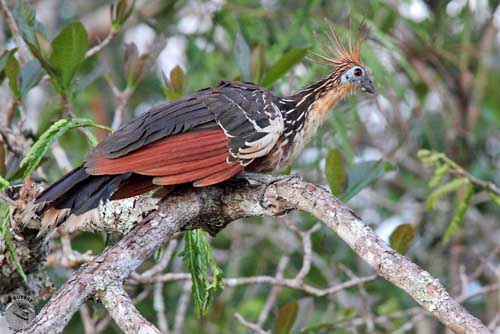
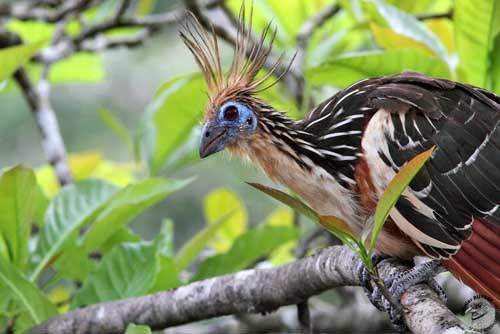
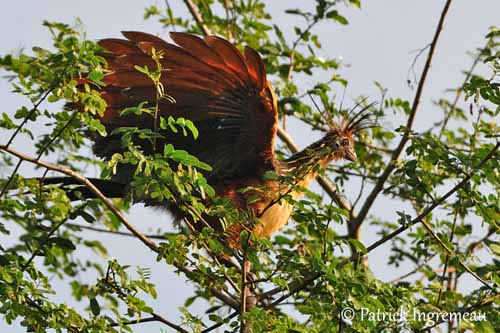
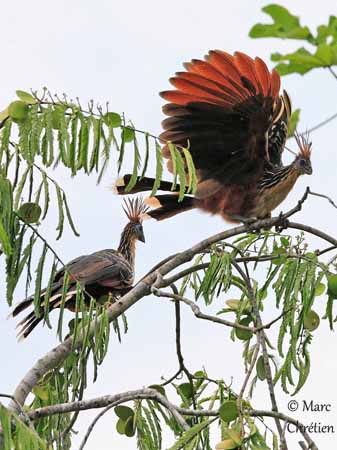
HABITAT:
Hoatzin lives in flooded forests along streams, mangroves, swamps, where they can find aquatic vegetation, mainly giant arums which are their preferred food.
RANGE:
Hoatzin lives only in South America, in Amazon and Orinoco swamps, Guyana and Venezuela, south to Bolivia, Peru and Amazonian Brazil. This species is resident in its range and found from lowlands to 500 metres of elevation.
Hoatzin ranges in Amazon and Orinoco basins, and various streams and marshes within this aquatic complex.
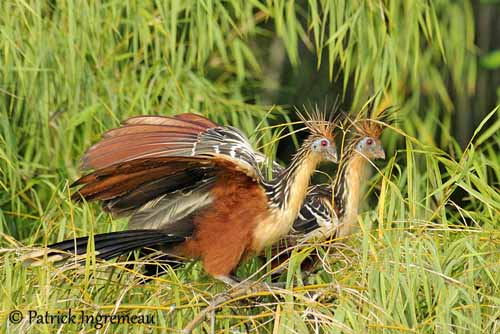
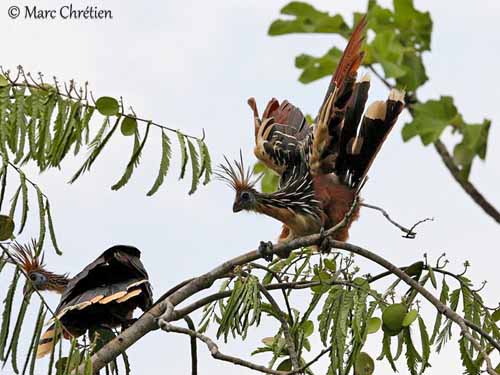
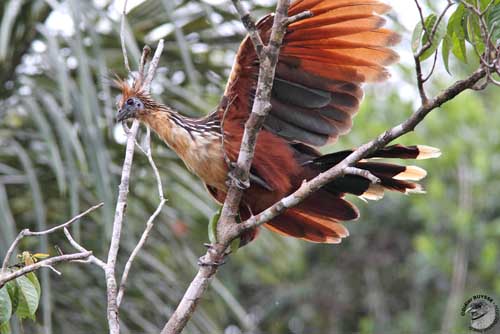
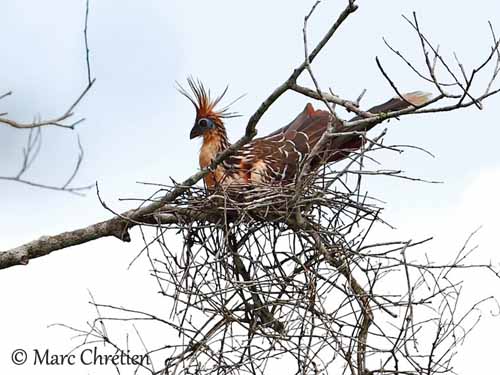
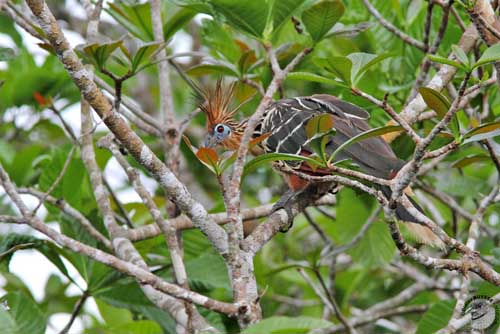
Female lays 2, sometimes 3 creamy eggs, with blue, pink or brown spots. Incubation lasts about 28 to 32 days, by both parents which take turns in sitting.
Chicks hatch naked, but their down grows rapidly. They may leave the nest very soon after hatching, and they are able to climb on branches and vegetation. Chicks have an anatomical particularity. They have two claws on first and second phalanxes on wing articulation. They use these hooked claws for climbing on branches around the nest.
If alarmed or endangered, chicks may climb up in tree, using claws, bill and feet, but they can also drop into the water below the nest, swimming under the surface to escape predator. Then, they use again their claws to come back to the branches within their natal territory.
